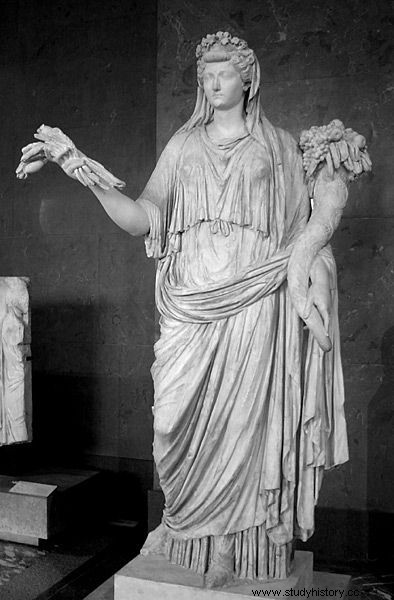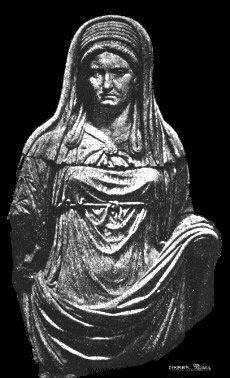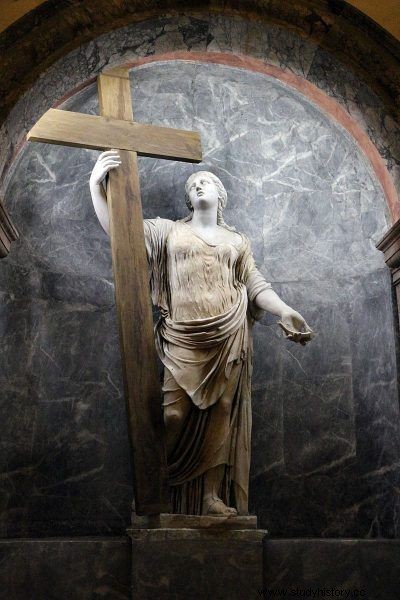Ancient Roman women had a clearly designated place in society. From time to time, however, there were those that crossed the border in the hierarchy assigned to them. As a result, several important, outstanding and ambitious women have been written in the history of the Eternal City - here are a few of them.
Livia Druzylla - the first empress of Rome
Livia Druzylla was born on January 30, 58 BCE. in one of the most eminent families of ancient Rome - Claudius. Its members derived their origin from Aeneas himself - the founder of Rome. As a young girl, Livia was married to her cousin Tiberius Claudius Nero, to whom she gave birth to two sons. The first was Tiberius - the future emperor of Rome; the second was Druzus, whom she gave birth to after divorcing and remarrying. The future Emperor Octavian was her new chosen one.
Octavian's marriage with Livia Druzylla united two of the most outstanding families of ancient Rome. Its origin and proven fertility allowed the future emperor to strengthen his position in the state. However, Livia's role was not limited to an obedient wife and exemplary matron. She played a very large role in the politics of the time - especially in the propaganda that shaped Octavian himself. As the opposite of dissolute Cleopatra, she was posed, along with Octavian's sister - Octavia, as a model of female virtues. Legends grew around her figure.
The quintessence of this role was to give both Livia and Octavia rights that so far were not possessed by any Roman woman. In 35 B.C.E. Octavian gave them both the legal protection sacrosanctitas until now only people's tribunes. In practice, this meant that insulting them became a crime .
The second privilege was to release both women from tutela that is, the supervision of a man, thanks to which both were responsible for their own finances. Moreover, this status equated them with the most venerated group of women in Rome - the Vestals.
The third privilege was to allow the official statues to be made Livia and Octavia for public presentation. It was certainly a response to the Antony propaganda and the Cleopatra statues that were widely exhibited. However, no such practice was carried out in Rome. The only official monument of a Roman woman so far, unfortunately not preserved to our times, was the statue of the mother of the Grakch brothers - Cornelia.

Livia Druzylla was one of the first women of Rome whose statues were put on display
Livia Druzylla became the wife of Emperor Augustus and the founding mother of the Julio-Claudian dynasty. However, her husband, as emperor, gave her the title of "Augustus" only after his death in his will, which was also the result of his strongly defined policy. Livia was a strong empress, mother and wife. She died in 29 CE and was included among the gods as "Diva Augusta" . In a sea of contradictory opinions and facts, historians find it extremely difficult to make an objective assessment of her person. We do know the opinion of her grandson Claudius, who called her "Ulysses in a woman's dress" . If this opinion is true, then she was a woman as wise as it was dangerous and deceitful .
Holy priestesses
Undoubtedly, the most respected women in ancient Rome were the priestesses of the goddess Vesta, commonly known as the Vestals . The worship of this goddess was one of the oldest and is believed to have been established by Numa Pompilius (715-673 BCE). Initially, there were only two priestesses, but with time this number increased to six.
The vestals were selected by lot by the high priest - Pontifex Maximus; This does not mean, however, that every girl living in Rome at any given time could become a holy priestess. The selection of candidates was subject to very restrictive rules . They were girls aged 6 to 10, born in respected and well-situated families - originally patricians. The candidate had to be a virgin without any defects on her body and she could not even be a half-orphan.
The young vestal was obliged to serve for 30 years, but most of them decided to remain in the priesthood until the end of their lives. The young adept had to live with other priestesses in the temple at the Roman Forum called Vestae Atrium where under the watchful eye of the superior of Virgo Vestalis Maxima she was alive and fulfilling her duties.
The most important tasks of the Vestals were to guard the holy fire and make sacrifices, as well as baking the sacred salted pies called mola salsa . Priestesses also cared for sacred objects, guarded and ritually cleaned the temple and warehouse. Their tasks were extremely important to the welfare of Rome and its inhabitants, as evidenced by the penalties applied for their non-performance.
A flogging was waiting for the priestess for neglecting the holy fire, which led to its extinction. The penalty for not keeping the vow of chastity was walling it up alive or burning it . Why did the Romans choose such cruel punishment for their most holy priestesses? Precisely because of this holiness! For no man had the right to shed the vestal's blood. For this reason, they were usually sentenced to be walled alive, leaving only a small window through which a small amount of food was supplied. As a result, the priestess was starving.
It happened that in the great tragedies and disasters affecting Rome, the fault of the Vestals was found to break the vows of chastity. In 216 B.C.E. on the news of the defeat at Cannae, as many as 2 priestesses were sentenced - one of them was forced to commit suicide, the other was walled up alive. Three Vestals caught in a sex scandal in 114 or 113 and another three in 83 were also sentenced to death by starvation. In the year 90 was buried alive Virgo Vestalis Maxima Cornelia .

The head of the Vestals, Cornelia, was sentenced to be buried alive
The vestals combined all female roles. The robe they wore corresponded to that of a matron, the hairstyle pinned up in six locks was characteristic of the bride, and the cleanliness they were supposed to maintain combined them with the innocence of young brides . They also linked religious home life with community life - their household was Rome, and if something did not go well, it affected everyone.
The priestesses of the goddess Vesta were highly valued in Roman society, and they were extremely influential, especially when they decided to intercede for someone. They were accompanied by liqueurs, they could enjoy honorable seats in the theater, had the right to grace the convicts and their testimonies were tantamount to oaths. Wills of, among others, Caesar and Mark Antony.

Vestal dress reflected their multiple roles in society:matrons, brides and virgins
Helena - mother of the first Christian emperor
Helena's story is unusual for a Roman woman. She was of little birth, her parents were unknown, and yet she made history more strongly than all the empresses put together before her.
As far as we know, Helena was the owner of an inn in the small village of Drepanum in Asia Minor, or she used to work in it when the young military commander Constantius stood in her way. St. Ambrose, quoting the story of this meeting, informs us that the young commander then satisfied his desires, as a result of which the future emperor Constantine was born . We have no evidence that Constantius married Helen; on the contrary, it seems that she was completely ousted while her chosen one married Theodora, stepdaughter of one of his comrades-in-arms.
There are many stories about further events, but all of them boil down to the fact that Constantine, an adult after the death of his father in 306, proclaimed himself emperor and had to prove his right to the throne. Upon assuming power, Constantine held his mother in great respect and reverence . She was given enormous estates that she could dispose of herself. She supported Christian communities, built churches, and subsidized the army.
In 325, she was dubbed "Augustus," and her image appeared on coins, at that time not bearing any Christian symbols. Shortly after the death of her beloved grandson, Helena went on a pilgrimage to the Holy Land, thus creating a model for such a journey for subsequent pious pilgrims .
During her trip, she visited holy places connected with the life of Christ:his grotto in Bethlehem, the place of his crucifixion and the tomb of the Resurrection. With time it was announced that during her pilgrimage she found the remains of three crosses, one of which worked a miracle restoring a seriously ill woman to health. Part of the Holy Cross was then taken with her to Rome, which gave rise to the cult of the relics .

St. Helena in the Church of Santa Croce in Gerusalemme is in fact a monument to Juno found in Ostia, where the head and the hands that hold the cross are replaced
Helena died shortly after returning from the pilgrimage in AD 330 and was buried in Rome. The great hall of her palace was rebuilt into a church (currently called Santa Croce in Gerusalemme - Holy Cross in Jerusalem), where, according to tradition, the relics of the Holy Cross are still to this day. In the crypt of the church there is a statue of Helena with a cross, which is in fact a statue of Juno, once found in Ostia, in which the head was replaced and the hands holding the cross were added. For their views, incl. that Christ was not the son of God, but his most perfect creation, was condemned at the Council of Nicaea. However, this did not prevent her from being elevated to the altars as a saint in the 9th century.
The title of women of merit in ancient Rome can be attributed to many of the ladies of that time. History has treated some very kindly, as in the case of Livia Druzylla, St. Helena, or most of the holy priestesses of the goddess Vesta. They are considered great and good empress, faithful priestesses who care for the well-being of the whole society . The ancients decided to deal with others very brutally ... But that's a completely different story.
